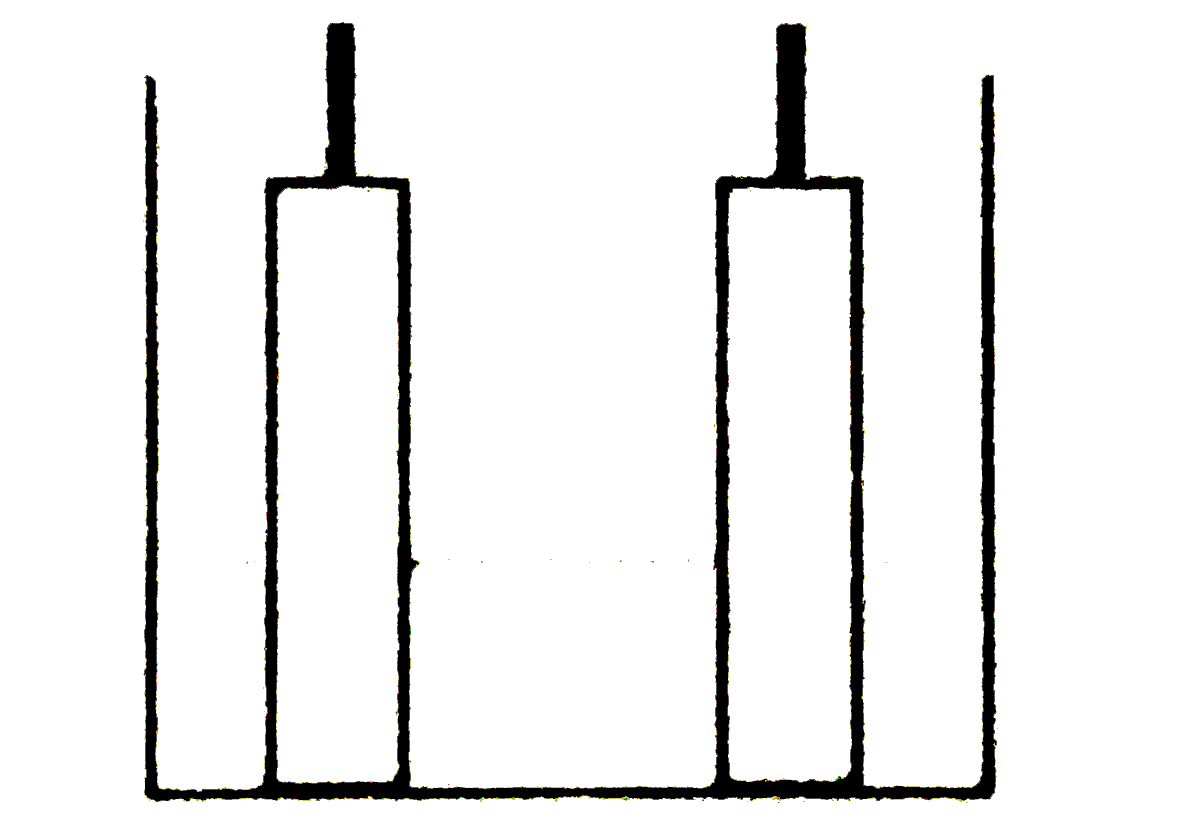A resistance of 50Ω is registered when two electrodes are suspended into a beaker containing a dilute solution of a strong electrolyte such that exactly half of them are submerged into solution as shown in figure. If the solution is diluted by adding pure water (negligible conductivity) so as to just completely submerge the electrodes, the new ressitance offered by the solution would be: ltbegt 
50Ω
100Ω
25Ω
200Ω
The correct Answer is:A
R=1klA
The k is halved while the A is doubled.Hence R remains 50Ω.
Topper's Solved these Questions
Similar Questions

A resistane of 50Ω is registered when two electrodes are suspended into beaker containing a dilute solution of a strong electrolyte such that exactly half of the them are submerged into solution. If the solution is diluted by addig pure water (negligible conductivity) so as to just completely submerge the electrodes. the new resistance offered by te solutio would be .
(A). 50Ω
(B). 100Ω
(C). 25Ω
(D). 200ΩView Solution1.0 N solution of a salt surrounding two platinum electrodes 2.1 cm apart and 4.2 sq cm in area was found to offer a resistance of 50 ohm. Calculate the equivalent conductivity of the solution.
View Solution
Knowledge Check
- Question 1 - Select One
In a conductivity ecll the two patinum electrodes, each of area 10sq. Cm si fixed 1.5cm apart . The cell contained 0.05N solution of a salt. If the two electrodes are just half dipped into the solution which has a resistance of 50Ω, find equivalent conductance of the salt solution .
A120Scm2eq−1B160Scm2eq−1C120Sm2eq−1D125Scm2eq−1 - Question 2 - Select One
Electrolysis is the decomposition of an electrolyte on passing current and it involves the migration of the ions of the electrolyte towards oppositely charged electrodes. Reduction occurs at cathode by the gain of electrons while oxidation at the anode by the loss of electrons. The electrical conductivity of an electrolyte increases upon dilution as well as with the increase in temperature. The nature of the products formed at the respective electrodes depends upon the nature of the electrodes as well as the nature of electrolyte whether in molten state or in aqueous solution. The mass of the substance deposited at a particular electrode is guided by the Faraday's first and second laws of electrolysis.
In and electrolytic cell, one litre of 1 M aqueous solution of MnO4 is reduced at the cathode. The quantity of electricity required, so that the final solution is 0.1 MnO24, will be :A0.1 FB1 FC10 FD100 F - Question 3 - Select One
The resistance of 0.5M solution of an electrolyte in a cell was found to be 50Ω. If the electrodes in the cell are 2.2cm apart and have an area of 4.4cm2 then the molar conductivity (in Sm2mol−1) of the solution is
A0.2B0.02C0.002Dnone of these
In a conductivity cell the two platinum electrodes each of area 10 sq. cm are fixed 1.5 cm apart. The cell. Contained 0.05N solution of a salt. If the two electrodes are just half dipped into the solution which has a resistance of 50 ohms, find equivalent conductance of the salt solution.
View SolutionIn a conductivity cell the two platinum electrodes each of area 10 sq. cm are fixed 1.5 cm apart. The cell. Contained 0.05N solution of a salt. If the two electrodes are just half dipped into the solution which has a resistance of 50 ohms, find equivalent conductance of the salt solution.
View SolutionThe resistance of a 0.5 M solution of an electrolyte was found to be 30 Ω enclosed between two platinum electrodes. Calculate the molar conductivity of the solution if the electrodes in the cell are 1.5 cm apart and having an area of cross section 2.0 cm2?
View SolutionRead the given passage and answer the questions number that follow :
Molar conductivity increases with decrease in concentration. This is because the total volume, V, of solution containing one mole of electrolyte also increases. It has been found that decrease in K on dilution of a solution is more than compensated by increase in its volume. Physically, it means that at a given concentration, Am can be defined as the conductance of the electrolytic solution kept between the electrodes of a conductivity cell at unit distance but having area of cross-section large enough to accommodate sufficient volume of solution that contains one mole of the electrolyte. When concentration approaches zero, the molar conductivity is known as limiting molar conductivity and is represented by the symbol Λm The variation in Am with concentration is different for strong and weak electrolytes.
Is the variation in Λm with concentration same or different for weak and strong electrolytes ?View SolutionRead the given passage and answer the questions number that follow :
Molar conductivity increases with decrease in concentration. This is because the total volume, V, of solution containing one mole of electrolyte also increases. It has been found that decrease in K on dilution of a solution is more than compensated by increase in its volume. Physically, it means that at a given concentration, Am can be defined as the conductance of the electrolytic solution kept between the electrodes of a conductivity cell at unit distance but having area of cross-section large enough to accommodate sufficient volume of solution that contains one mole of the electrolyte. When concentration approaches zero, the molar conductivity is known as limiting molar conductivity and is represented by the symbol Am The variation in Λm with concentration is different for strong and weak electrolytes.
Why does molar conductivity increase with decrease in concentration ?View Solution
